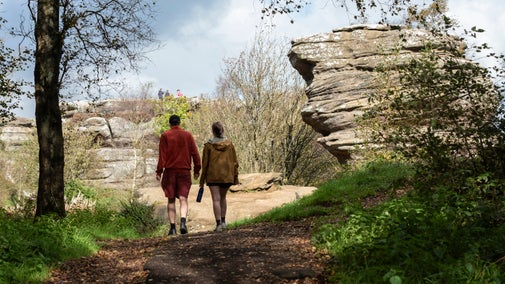
Discover more at Brimham Rocks
Find out how to get to Brimham Rocks, where to park, the things to see and do and more.

Find out how our countryside team of staff and volunteers help to maintain and conserve the moorland at Brimham, from the trialling of different bracken control techniques to the introduction of Belted Galloway cattle to graze the moorland vegetation.
In 2023 we re-introduced cattle to graze the moorland at Brimham Rocks. The herd of Belted Galloways, a gentle but hardy breed, graze the moorland vegetation to maintain a healthy habitat between May and October.
Grazing is an important part of moorland management. The cattle graze and eat the young saplings to maintain a healthy, mixed-age structure of vegetation help us to manage the moorland more effectively and sustainably.
To manage the cattle we've put up a fence around their roaming area on the south and north moors. To maintain Brimham moorland as open access land we've installed gates on public rights of way and stiles at access points along the boundary of the fence too.
There won’t be any livestock in the main visitor area or car parks.
- Alec Boyd, Area Ranger Brimham Rocks

Grazing will improve the habitat on Brimham Moor as the cattle will:
- Alec Boyd, Area Ranger Brimham Rocks
The Belted Galloways chosen to graze the site are hard-mouthed and browse as well as graze a variety of vegetation. They are a placid breed and importantly are not be fazed by members of the public and their dogs.
The cattle are only on site for the summer months, May to October. The timing and intensity of the grazing may be altered as time goes on, to ensure that they are having the right impact. Getting the grazing levels right is going to be our biggest challenge.
We will carefully monitor the habitat throughout the years to come, to ensure that the cattle are having the desired effect. This may involve increasing or decreasing numbers where necessary, or moving the cattle around the site to target their grazing. We will continue to monitor the landscape and will keep everyone informed as to any changes we may make in the future.
Brimham Rocks is one of just over 4,000 sites nationwide that have been awarded the status Site of Special Scientific Interest’ (SSSI). Attributed by Natural England, this status is used to protect the natural, environmental or geological heritage of the British Isles from development, pollution or insensitive land management.

Being given this status is certainly a form of recognition of the uniqueness of the site, but also places a great deal of responsibility on the shoulders of the conservation staff who work here.
On a world scale, natural heather habitats are extremely rare: rarer than rainforest. According to the Moorland Association, 75% of the world's remaining heather moorland is found in Britain and that habitat has been declining rapidly.
Brimham moor has the particular distinction of being home to three local varieties: ling heather, bell heather and cross-leaved heath. With its rapid growth and extended root system, if left unattended, bracken would soon damage the heather moorland beyond repair.
The countryside team of staff and volunteers perform regular trials of different bracken control techniques. A recent Higher Level Stewardship grant has made all the difference to the team’s ultimate success or failure in bracken control, as it has made possible the purchase of the necessary equipment.
A selective herbicide is used, which only harms bracken and dock. It thoroughly eradicates bracken at its root, resulting in seven to eight years of managed countryside. This makes it more difficult for the weed to re-establish a presence on the site and giving subsequent ‘natural’ methods of control, such as flailing and manual pulling, a much higher chance of success.
Our work to preserve this precious natural resource is always ongoing and we are always interested to hear from people interested in volunteering to help conserve this natural moorland habitat for generations to come.
There are several things you can do to help us manage Brimham Rocks:
With your ongoing support, we're able to continue our vital conservation work. Thank you for helping to protect these special places.

Find out how to get to Brimham Rocks, where to park, the things to see and do and more.

There are plenty of ways to explore Brimham Rocks, from walking and cycling, to orienteering and geocaching. Discover the outdoor activities on offer.

Discover the millions of years of natural history evident at Brimham Rocks, which has been enchanting visitors for centuries.

From rocks to moorland, Brimham offers a whole host of different features for visitors to explore. Here are a few highlights and what not to miss on your first, second or thousandth visit.

We welcome all groups at Brimham Rocks and are open throughout the year. If you are planning to visit with a group, you’ll need to book in advance. Click here to make your booking and find out more.

Read about our strategy, which focuses on restoring nature, ending unequal access and inspiring more people.

We believe that nature, beauty and history are for everyone. That’s why we’re supporting wildlife, protecting historic sites and more. Find out about our work.